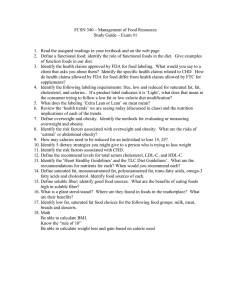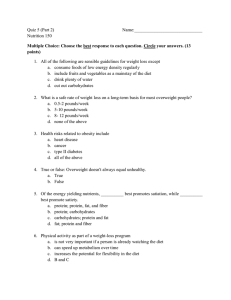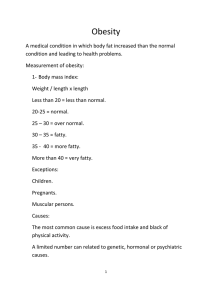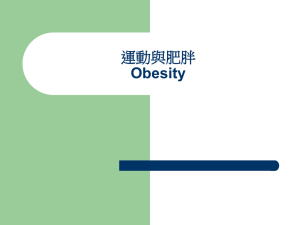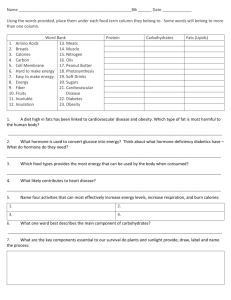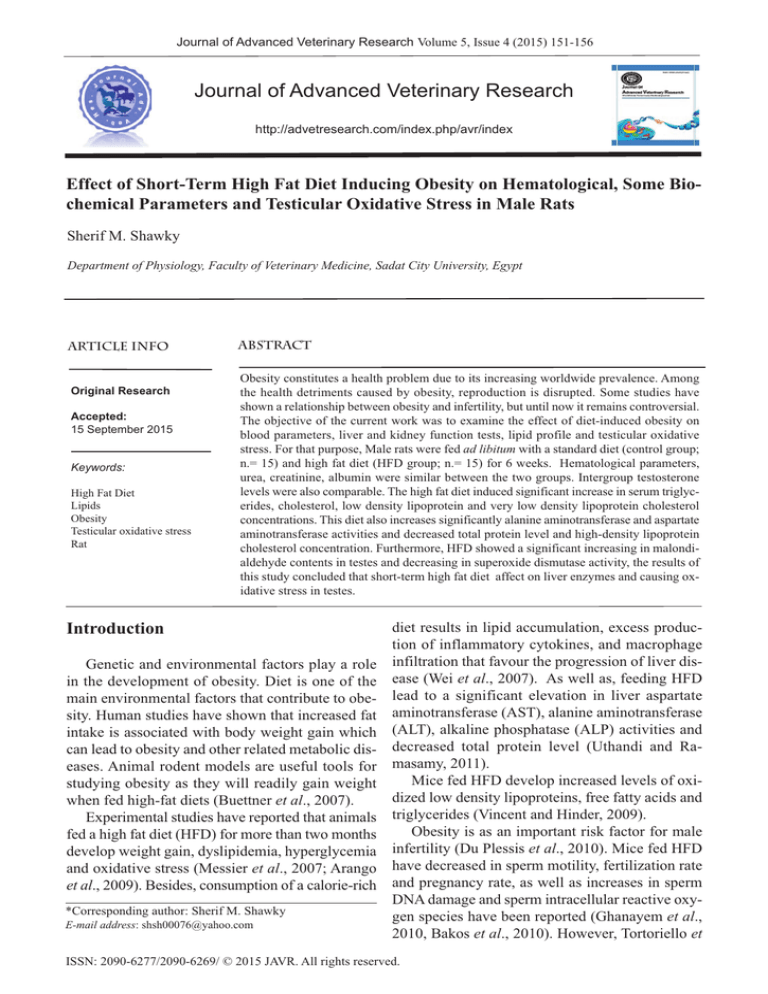
Journal of Advanced Veterinary Research Volume 5, Issue 4 (2015) 151-156
Journal of Advanced Veterinary Research
http://advetresearch.com/index.php/avr/index
Effect of Short-Term High Fat Diet Inducing Obesity on Hematological, Some Biochemical Parameters and Testicular Oxidative Stress in Male Rats
Sherif M. Shawky
Department of Physiology, Faculty of Veterinary Medicine, Sadat City University, Egypt
ARTICLE INFO
Original Research
Accepted:
15 September 2015
Keywords:
High Fat Diet
Lipids
Obesity
Testicular oxidative stress
Rat
Introduction
ABSTRACT
Obesity constitutes a health problem due to its increasing worldwide prevalence. Among
the health detriments caused by obesity, reproduction is disrupted. Some studies have
shown a relationship between obesity and infertility, but until now it remains controversial.
The objective of the current work was to examine the effect of diet-induced obesity on
blood parameters, liver and kidney function tests, lipid profile and testicular oxidative
stress. For that purpose, Male rats were fed ad libitum with a standard diet (control group;
n.= 15) and high fat diet (HFD group; n.= 15) for 6 weeks. Hematological parameters,
urea, creatinine, albumin were similar between the two groups. Intergroup testosterone
levels were also comparable. The high fat diet induced significant increase in serum triglycerides, cholesterol, low density lipoprotein and very low density lipoprotein cholesterol
concentrations. This diet also increases significantly alanine aminotransferase and aspartate
aminotransferase activities and decreased total protein level and high-density lipoprotein
cholesterol concentration. Furthermore, HFD showed a significant increasing in malondialdehyde contents in testes and decreasing in superoxide dismutase activity, the results of
this study concluded that short-term high fat diet affect on liver enzymes and causing oxidative stress in testes.
Genetic and environmental factors play a role
in the development of obesity. Diet is one of the
main environmental factors that contribute to obesity. Human studies have shown that increased fat
intake is associated with body weight gain which
can lead to obesity and other related metabolic diseases. Animal rodent models are useful tools for
studying obesity as they will readily gain weight
when fed high-fat diets (Buettner et al., 2007).
Experimental studies have reported that animals
fed a high fat diet (HFD) for more than two months
develop weight gain, dyslipidemia, hyperglycemia
and oxidative stress (Messier et al., 2007; Arango
et al., 2009). Besides, consumption of a calorie-rich
*Corresponding author: Sherif M. Shawky
E-mail address: shsh00076@yahoo.com
diet results in lipid accumulation, excess production of inflammatory cytokines, and macrophage
infiltration that favour the progression of liver disease (Wei et al., 2007). As well as, feeding HFD
lead to a significant elevation in liver aspartate
aminotransferase (AST), alanine aminotransferase
(ALT), alkaline phosphatase (ALP) activities and
decreased total protein level (Uthandi and Ramasamy, 2011).
Mice fed HFD develop increased levels of oxidized low density lipoproteins, free fatty acids and
triglycerides (Vincent and Hinder, 2009).
Obesity is as an important risk factor for male
infertility (Du Plessis et al., 2010). Mice fed HFD
have decreased in sperm motility, fertilization rate
and pregnancy rate, as well as increases in sperm
DNA damage and sperm intracellular reactive oxygen species have been reported (Ghanayem et al.,
2010, Bakos et al., 2010). However, Tortoriello et
ISSN: 2090-6277/2090-6269/ © 2015 JAVR. All rights reserved.
Sherif M. Shawky /Journal of Advanced Veterinary Research 5 (4) (2015) 151-156
al. (2004) found no impairment in the fertility of
male mice after they were fed HFD. Sprague-Dawley rats fed HFD from weaning to 90 days had a
reduction in testosterone levels (Vigueras-Villaseñor et al., 2011), and male mice fed HFD (for
9 weeks) showed a trend toward reduction in
testosterone levels compared to the control group
(Bakos et al., 2010). In addition, obesity increased
oxidative stress in reproductive system that defined
as stress induced by increased numbers of molecules containing free oxygen. High fat diet increased malondialdehyde (MDA) contents of testes
(Galaly et al., 2014).
There is no available literature about the effect
of fat inducing diet on hematological parameter, as
well as relationship between obesity and infertility
still controversial and not full studied Therefore,
the aim of this study was to determine the effect of
high-fat diet induced obesity on hematological,
biochemical parameters and testicular oxidative
stress in male rat.
gredient were performed according to (Khalifa,
2010).
Chemical and ingredient compositions of high fat
diet
Blood sampling
At the end of the experiment, blood samples
collected from retro-orbital puncture under diethyl
ether anesthesia. Blood samples were drawn into
Materials and methods
dry tubes (for obtaining serum) and heparinized
tubes (for obtaining whole blood). Serum were sepAnimal model
arated by centrifugation and stored at -20°C for
Thirty male Wister rats (100-120 g) were used subsequent analysis
in this experiment. Animals were obtained from AlZyade experimental animal production center, Hematological and Biochemical Investigations
Giza, Egypt. Animals were quarantined and alHematological parameters were determined by
lowed to acclimate for a week prior to the experiment. The animals were handled under standard standard methods. Hemoglobin concentration was
laboratory conditions of a 12-hour light/dark cycle determined by the Cyanomethemoglobin Method
in a temperature and humidity-controlled room. (Pilaski, 1972). Packed cell volume (PCV) was deWater and feed were supplied ad libitum. All ani- termined by microhematocrit method as described
mal-handling procedures were carried out follow- by Feldman et al. (2000) using microhematocrit
ing the regulations of Institutional Animal Ethics centrifuge (TGM12 capillary hematocrit cenCommittee and with their prior approval for using trifuge). The red cells (RBC) were counted under
the high power of microscope (MSK-1 light microthe animals.
scope) by using double improved Neubauer counting chamber (Feldman et al., 2000) and white
Experimental protocol
blood cells (WBC) were counted under the low
Rats were randomly divided into two groups of power of microscope by using double improved
fifteen animals each (n.=15). Group 1 served as Neubauer counting chamber (Wintrobe et al.,
control and received water and feed ad libitum. 1967).
The activities of serum AST and ALT were esGroup 2 (obese group) rats were fed on high fat diet
timated according to the method of Young (2001),
for 6 weeks.
Total protein was estimated by the method of
Young (2001). Urea was estimated by the method
High fat diet (HFD)
of Patton and Croush (1977) and creatinine was esChemical analysis of HFD pellets and pellets in- timated by the method of Young (2001) using Dia152
Sherif M. Shawky /Journal of Advanced Veterinary Research 5 (4) (2015) 151-156
mond Diagnostic Kits obtained from Mid-Egypt
Company.
The serum cholesterol concentration was determined according to method of Young (2001). Determination of high-density lipoproteins cholesterol
(HDL-cholesterol) level was carried out according
to the method of Grove (1979). Serum triglycerides
level was determined according to the method of
Young (2001) using Spinreact Diagnostic Kits obtained from Mid-Egypt Company.SQ4802 Spectrophotometer (Unico, USA) used for measuring
the levels of different parameters.
Low density lipoprotein cholesterol (LDL-cholesterol) level and very low-density lipoprotein
cholesterol (VLDL-cholesterol) were calculated as
described by Friedewald (1972) as follows:
The serum testosterone level was assayed by
ELISA radio immunoassay (Wilson and Foster,
1992). Using kits of Hellabio biokits Company
(USA) and following the manufacturer’s instructions. The amount of testosterone was expressed as
ng/ml.
Preparation of testicular tissue samples
method of Yashkochi and Masters (1979). MDA reacts with thiobarbituric acid (TBA) in an acid
medium giving a colored TBA-complex measured
colorimetrically at 520-535 nm against blank and
MDA values were expressed as n moles MDA/gm
tissue protein.
Measurement of testicular Superoxide Dismutase
Activity
Superoxide dismutase (SOD) activity was estimated according to Giannopolitis and Ries (1977).
The optical absorbance was measured at wave
length 560 nm against blank reagent. SOD= Reading (absorbance) of (SOD)/ g tissue protein.
Protein determination
The total protein concentration of supernatant was
determined by the method of Young (2001).
Statistical analysis
All data were expressed as mean ± standard error
(SE). Paired t-test was used to compare control and
fat inducing diet variables. Differences were considered significant when p values were less than
0.05. All analysis was performed using the statistical package (SPSS) version 16.0 (Chicago, IL,
USA).
The testis was removed and quickly excised,
minced with ice cold saline, blotted on filter paper Results
and homogenized in phosphate buffer (pH7.4), the
supernatant were frozen at -20oC for further deter- Effect of high fat diet on body weight
mination of antioxidant enzyme activities and
MDA level. Tissue homogenate was prepared acThe present data showed that there was no sigcording to Combs et al. (1987).
nificant difference at the beginning of the experiment in initial weight of rats in two groups while
Lipid Peroxidation and Antioxidant Enzyme
the significant difference (p <0.05) present at the
end of the experiment in the body weight of HFD
Measurement of testicular Malondialdehyde group compared to control group (Table 1).
(MDA) Concentration
Malondialdehyde was determined by the
Table 1. Effect of high fat diet on body weight
153
Different letters in the same raw show significant difference at the level of p <0.05
Sherif M. Shawky /Journal of Advanced Veterinary Research 5 (4) (2015) 151-156
Effect of high fat diet on hematological parameters
Effect of high fat diet on testosterone hormone and
testicular oxidative markers
The results of hematological parameters have
been summarized in Table 2. HFD rats exhibited
Data in Table 6 showed that there is no signifino significant changes in Hb, PCV, WBCs and cant difference in serum testosterone levels beRBCs, in compare with control one.
tween HFD animals and control animals while
there is a significance increase in MDA level and
Table 2. Effect of fat inducing diet on hematological param- significance decrease SOD in HFD group in cometers in rats
pare with control one.
Table 6. Effect of fat inducing diet on serum testosterone,
malondialdehyde and superoxide dismutase in testicular tissue in rats
Effect of high fat diet on biochemical parameters
The results of biochemical parameters have
Different letters in the same raw show significant difference at the
been summarized in Tables 3, 4 and 5. High fat diet level of p <0.05
induced a significant increase (P < 0.05) in ALT,
AST, cholesterol, triglyceride, LDL-cholesterol Discussion
and VLDL-cholesterol. On the other hand caused
a significant decrease in total protein and HDLThe high-fat diet used in the present study was
cholesterol and had no effect on albumin, urea and
effective in promoting obesity, as demonstrated by
creatinine.
a significant increased in body weight. Fat deposits,
adiposity
index Body weight, and serum leptin inTable 3. Effect of fat inducing diet on Total protein, Albumin,
creased significantly in animals feeding with high
AST and ALT in rats
fat diet (Fernandez et al., 2011).
The obtained data revealed that there was no
significant difference in the blood picture of high
fat fed rats in compare with control group this may
be attributed to the change in hematological paramDifferent letters in the same raw show significant difference at the eters as a result of high fat diet may need long term
level of p <0.05
exposure not short term, no available literatures
Table 4. Effect of fat inducing diet on urea and creatinine in about the effect of high fat diet on blood picture,
rats
however this point need further investigation.
In the present investigation, the increased levels
of ALT and AST have been observed in serum of
high-fat fed rat compared to control groups (Table
3) indicating the harmful effect of HFD on the liver.
An elevation in the levels of serum marker enzymes is generally regarded as one of the most senTable 5. Effect of fat inducing diet on triglyceride, total chositive
index of the hepatic damage (Kapil et al.,
lesterol, HDL cholesterol, LDL cholesterol and VLDL cho1995). Observed elevated levels of ALT and AST
lesterol
in serum of HFD fed rat indicates that the elevation
might be due to hepatocellular damage caused by
HFD toxicity. The findings of the present study
match the result of Uthandi and Ramasamy (2011)
who reported that HFD caused a significant increase in the serum levels of AST, ALT and ALP.
Similarly, Recknagel (1987) reported that the heDifferent letters in the same raw show significant difference at the
level of p <0.05
patic damage induced in HFD fed animal resulted
154
Sherif M. Shawky /Journal of Advanced Veterinary Research 5 (4) (2015) 151-156
in elevation in the level of AST and ALT in the
blood. Also, in the present study, serum protein levels were decreased in HFD fed rats. The depletion
in the protein levels might be due to localized damage in the endoplasmic reticulum or hazard effect
of energy which librate through the metabolism of
HFD (Uthandi and Ramasamy, 2011).
The obtained data revealed that increased serum
total cholesterol, triglyceride, LDL-cholesterol and
VLDL-cholesterol in high fat diet group (Table 5).
The results were in agreement with that obtained
by Suliman (2008) who stated that HFD increase
the level of cholesterol. The increase level of cholesterol might be due to excessive loads of cholesterol on the liver resulting to down regulation of
LDL receptors which carry cholesterol lead to cholesterol being re-circulated in the blood (Mustad et
al., 1997). Mice fed HFD develop increased levels
of triglycerides, oxidized low density lipoproteins,
free fatty acids and VLDL-cholesterol (Vincent et
al., 2009)
Obesity is an important cause of adverse health
outcomes, including male infertility (Hammoud et
al., 2006). In the present study there is no significance difference in testosterone hormone levels between HFD group and control one. Contradictory
to the results in the present study Vigueras-Villaseñor et al. (2011) reported that Sprague-Dawley
rats fed HFD from weaning to 90 days had a reduction in testosterone levels. Male mice fed HFD (for
9 weeks) showed a trend toward reduction in
testosterone levels compared to the control group
(Bakos et al., 2010). In this study the adiposity gain
seen in the animals was not sufficient to produce a
significant diminution in the testosterone levels,
perhaps because the obesity installed was not severe, rats exposed to relatively short-term high fat
diet inducing obesity.
On the other hand HFD exhibited a significant
increase (P<.05) in testes MDA and significant decrease in SOD activity These findings are in accordance with those of Galaly et al. (2014) who stated
that male rats fed with a high fat diet had significantly higher levels of MDA and lower levels of
GSH and SOD compared with the control diet male
rats. Obesity may induce oxidative stress and increase testicular oxidative stress.
Conclusion
It should be stated that short-term high fat diet
155
inducing obesity has hazard effects on liver function tests, lipid profile and induced testicular oxidative stress in male rats, no alteration occur in
hematological parameters and kidney function test.
References
Arango, M., Tomasinellinato, C.E., Vercellinatto, I. M., Catalano, G., Collino, G., Fantozzi, R., 2009. Free
SREBP-1c in NAFDL induced by Western-type highfat diet plus fructose in rats. Radic. Bio. Med. 47,
1067-1074.
Bakos, H.W., Mitchell, M., Setchell, B.P., Lane, M., 2010.
The effect of paternal diet- induced obesity on sperm
function and fertilization in a mouse model. Int. J. Androl. 34 (1), 402-410.
Buettner, R., Scholmerich, J., Bollheimer, L.C., 2007. Highfat diets: modeling the metabolic disorders of human
obesity in rodents. Obesity (Silver Spring) 15, 798808.
Combs, G.F., Levander, O.A., Spallholz, J.E., Oldfield, J.E.,
1987. Textbook of Selenium in Biology and Medicine.
Part B, Van Hostrand Company, New York, pp. 752.
Du Plessis, S.S., Cabler, S., McAlister, D.A., Sabanegh, E.,
Agarwal, A., 2010. The effect of obesity on sperm disorders and male infertility. Nature Reviews Urology
7(3), 153-161.
Feldman, B.F., Zinkl, J.G., Jain, N.C., 2000. Schalms Veterinary Haematology. 5th Ed., Philadelphia:Williams and
Wilkins, pp. 21-100.
Fernandez, C.D.B., Bellentani, F.F., Fernandes, G.S.A., Perobelli, J.E., Favareto, A.P.A., Nascimento, A.F., Cicogna, A.C., Kempinas, W.D.G., 2011. Diet-induced
obesity in rats leads to a decrease in sperm motility.
Reproductive Biology and Endocrinology 9, 32.
Friedewald, W.T., Levy, R.I., Fredrickson, D.S., 1972. Estimation of concentration of LDL-Cholesterol in
plasma, without use of preparative ultracentrifuge.
Clin. Chem. 18, 499-50.
Galaly, S.R., Hozayen, W.G., Amin, K.A., Ramadan, S.M.,
2014. Effects of Orlistat and herbal mixture extract on
brain, testes functions and oxidative stress biomarkers
in a rat model of high fat diet. Beni-Suef University
Journal of Basic and Applied Sciences. 3, 93-105.
Ghanayem, B.I., Bai, R., Kissling, G.E., Travlos, G., Hoffler,
U., 2010. Diet-induced obesity in male mice is associated with reduced fertility and potentiation of acrylamide-induced reproductive toxicity. Biol. Reprod.
82(1), 94-104.
Giannopolitis, C.N., Ries, S.K., 1977. Superoxide dismutases occurance in higher plants. Plant Physiol. 59,
309-314.
Grove, T.H., 1979. Method for estimation of high-density
lipoprotein cholesterol. Journal of Clinical chemistry
25, 560.
Hammoud, A.O., Gibson, M., Peterson, C.M., Hamilton,
B.D., Carrell, D.T., 2006. Obesity and male reproductive potential. J. Androl. 27(5), 619-626.
Kapil, A., Suri, O.P., Koul, I.B., 1995. Antihepatotoxic effects
of chorogenic acid from Anthrocephalus cadamba.
Sherif M. Shawky /Journal of Advanced Veterinary Research 5 (4) (2015) 151-156
Phytotherapy Research 9,189-193.
Khalifa, H.K.B. 2010. Biochemical effect of some medical
plants on the lipid aspects in obese rats. M.V.Sc. Thesis Biochemistry Department Fac.Vet.Med., Menoufia
Univ.
Messier, C., Whitely, K., Liang, J., Du, L., Pussiant, D., 2007.
The effects of high-fat, high fructose and combination
diet on learning, weight, and glucose regulation in
C57B/6 mice. Behave. Brain. Res. 178, 139-145.
Mustad, V.A., Etherton T.D., Cooper A. D., Mastro A.M.,
Pearson, T.A., Jonnalagadda, S.S., Kris-Etherton,
P.M., 1997. Reducing saturated fat intake is associated
with increased levels of LDL-receptors on mononuclear cells in healthy men and women. J. Lipid Res.
38, 459-468.
Patton, C.J., Croush. S.R., 1977. A colorimetric method o determination of plasma urea concentration. Anal.Chem.
46, 464-469.
Pilaski, J., 1972. Vergleichenda untersuchungen wher den hemoglobinehalf deshuhner and putenblutes in abhangigkeit. Vor aiter undegshlecht. Arch.
Eflugelkunde. 37, 70.
Recknagel, R.O., 1987. Carbon tetrachloride hepatotoxicity.
Pharmacol. Rev. 19, 145-195.
Suliman, S.H., 2008. The effect of feeding coriandrum
sativum fruits powder on the plasma lipids profile in
cholesterol fed rats. Research Journal of Animal and
Veterinary Sciences 3, 24-24.
Tortoriello, D.V., McMinn, J., Chua, S.C., 2004. Dietary-induced obesity and hypothalamic infertility in female
DBA/2J mice. Endocrinology 145(3), 1238-1247.
156
Uthandi, A., Ramasamy, K. (2011): Hepatoprotective activity
of sesame meal of high fat fed wistar rats. International Journal of Pharma Sciences and Research 2
(12), 205-211.
Vigueras-Villaseñor, R.M., Rojas-Castañeda, J.C., ChávezSaldaña, M., Gutiérrez- Pérez, O., García-Cruz, M.E.,
Cuevas-Alpuche, O., Reyes-Romero, M.M., Zambrano, E., 2011. Alterations in the spermatic function
generated by obesity in rats. Acta Histochem. 113(2),
214-220.
Vincent, A.M., Hinder, L.M., 2009. Hyperlipidemia new therapeutic target for diabetic neuropathy. Journal of the
Peripheral Nervous System 14(4), 257–267.
Wei, Y., Wang, D., Topczewski, F., Pagliassotti, M.J.P., 2007.
Fructose-mediated stress signaling in the liver: implication for hepatic insulin resistance. J. Nutr. Biochem.
18, 1-9.
Wilson, J.D., Foster, D.W., 1992. Willams Textbook of Endocrinology. Philadelphia Saunders, pp. 923-926.
Wintrobe, M.M.; Lee, G.R.; Boggs, D.R.; Bithell, T.C.;
Athens, J.W., Forester, J., 1967. Clinical Haematology. Lea and Febiger, Igaka Shoin, Philadelphia,
Tokyo., pp. 677.
Yashkochi , Y., Masters, R.S.S., 1979. Some properties of a
detergent. Solubilizied NADPA cytochromic (cytochrome P.450) reductase purified by biospecific
affinity chromatography. J. Biol. Chem. 251, 53375344.
Young, D.S., 2001. Effect of Drugs on Clinical Laboratory
Tests, 4th Ed. AAC.

